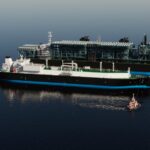Energy News Beat
DETROIT – Ford Motor is scaling back plans for a $3.5 billion battery plant in Michigan as consumers shift to electric vehicles more slowly than expected, labor costs rise and the company moves to cut costs.
Ford executives including CEO Jim Farley and Chair Bill Ford initially announced the facility in February. It quickly became a political target due to its connection to Chinese battery manufacturer Contemporary Amperex Technology Co., or CATL. The plant is a wholly owned Ford subsidiary, but the U.S. automaker is licensing technology from CATL to produce new lithium iron phosphate, or LFP, batteries for EVs.
Ford said Tuesday it is cutting production capacity by roughly 43% to 20 gigawatt hours per year and reducing expected employment from 2,500 jobs to 1,700 jobs. The company declined to disclose how much less it would invest in the plant. Based on the reduced capacity, it would still be about a $2 billion investment.
The decision adds to a recent retreat from EVs by automakers globally. Demand for the vehicles is lower than expected due to higher costs and challenges with supply chains and battery technologies, among other issues.
Reductions at the Marshall, Michigan, plant are part of Ford’s plans announced last month to cut or delay about $12 billion in previously announced EV investments. The company will also postpone construction of another electric vehicle battery plant in Kentucky.
“We looked at all the factors. Those included demand and the expected growth for EVs, our business plans, our product cycle plans, the affordability and business to make sure we can make a sustainable business out of this plant,” Ford Chief Communications Officer Mark Truby said during a media briefing. “After assessing all that, we are now good to confirm that we’re moving forward with the plant, albeit in a slightly smaller size and scope than what we originally announced.”
Truby said the plant is still expected to open in 2026, even though the company halted production of the facility for roughly two months during collective bargaining with the United Auto Workers. The talks ended last week as Ford-UAW employees ratified a deal that included significant wage increases and a path for battery workers at the plant to be included under the record agreement, if organized by the union.
The UAW did not immediately respond for a request for comment.
Increased labor costs factored into Ford’s decision to scale back the plans, according to Truby. Ford CFO John Lawler last month said the new deal would add $850 to $900 per vehicle assembled in labor costs.
Lawler declined to estimate how much the deal, which runs through April 2028, will cost the company. Deutsche Bank estimated the increase to be $6.2 billion during the terms of the deal.
“We’re still very bullish on EVs and our EV strategy, but clearly, while there is growth, both in the U.S. and worldwide, clearly, the growth isn’t at the rate that we and others had expected,” Truby said. “We’re trying to be smart about this and how we move forward.”
The plant has received political pushback from federal and local officials, including protests by residents in the rural Michigan city. U.S. lawmakers also have sought to review the licensing deal between Ford and CATL amid heightened tensions between the U.S. and China.
Truby reiterated Tuesday that the company still believes it’s better business for the company and U.S. to license the technology instead of importing batteries from overseas. The plant is expected to be the first in the U.S. to produce LFP batteries.
The lithium iron phosphate, or LFP, batteries the plant will produce are instead of pricier lithium-ion or nickel cobalt manganese batteries, which Ford is currently using. The new batteries are expected to offer different benefits at a lower cost, and allow Ford to increase EV production and profit margins.
Ford, which is currently sourcing LFP batteries from CATL, follows Tesla in using LFP batteries in a portion of its vehicles in part to reduce the amount of cobalt needed to make battery cells and high-voltage battery packs.
ENB Top News
ENB
Energy Dashboard
ENB Podcast
ENB Substack
The post Ford to scale back plans for $3.5 billion Michigan battery plant as EV demand disappoints, labor costs rise appeared first on Energy News Beat.








